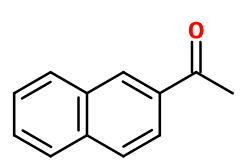
Crédits photo: ScenTree SAS
Oranger Crystals®
Méthyl Naphthyl Cétone ; 1-naphthalen-2-ylethanone ; Beta-acetonaphthalene ; 2-acetonaphthanone ; 2-acetylnaphthalene ; Cetone D ; 1-(2-naphthalenyl)-ethanone ; Methyl 2-naphthyl ketone ; MNK ; 1-naphthalen-2-yl-ethanone ; 2-naphthyl methyl ketone

Crédits photo: ScenTree SAS
| Entreprise | Nom de l'ingrédient | ID | Commentaires | Naturalité | Certifications | MOQ | Pureté |
|---|---|---|---|---|---|---|---|
|
|
Oranger Crystals - 30 Gr | - |
Visit website
|
- | - | - |
Général
-
N° CAS :
93-08-3 -
N° EINECS :
202-216-2 -
N° FEMA :
2723 -
N° FLAVIS :
07.013
-
N° JECFA :
811 -
Tenue :
Fond -
Gamme de prix :
€€
Propriétés physico-chimiques
-
Aspect :
Solide blanc -
Densité :
< 1,5 -
Indice de réfraction @20°C :
Data not available. -
Rotation optique :
Data not available. -
Pression vapeur :
Data not available. -
Point éclair :
154°C
-
Formule brute :
C12H10O -
Masse molaire :
170,21 g/mol -
Log P :
2,9 -
Point de fusion :
54°C -
Point d'ébullition :
301°C -
Seuil de détection :
Donnée indisponible.
Chimie & Utilisations
Utilisations :
L'Oranger Crystals® est utilisé dans des notes florales orangées et florales blanches pour un apport de chaleur. Utilisé dans les savons et les détergents pour sa stabilité. A tendance a tasser les formules en surdose.
Découverte :
1892
Présence dans la nature :
L'Oranger Crystals® n'est pas disponible à l'état naturel.
Isoméries :
L'alpha-Methyl Naphthyl Cétone, aussi appelé Oranger Liquid®, est un liquide possédant aussi une odeur proche de la fleur d'oranger. Ce composé est néanmoins différencié de l'Oranger Crystals® en parfumerie. L'Oxyde de diphényle est un isomère de constitution de l'Oranger Crystals®, mais possède une odeur très différente de ce dernier, tant elle est rosée et fruitée.
Précurseurs de synthèse :
L'Oranger Crystals® n'est pas précurseur de la synthèse d'un autre composé d'intérêt olfactif.
Voies de synthèse :
L'Oranger Crystals® est synthétisé à partir du naphtalène par une acétylation de Friedel-Craft, en le faisant réagir avec l'acide chloroacétique par exemple, en présence de chlorure d'aluminium. Plus le solvant utilisé pour cette synthèse est polaire, plus l'isomère béta de l'Oranger Crystals® sera présent en forte quantité dans le produit final. Le produit alpha n'est pas désiré.
Stabilité :
Stable en eau de toilette et en base fonctionnelle, hors détergents acides et javel. Très stable en bases de lessive.
Commentaires et anecdotes :
En le comparant aux autres notes du même type comme l'Anthranilate de méthyle ou le Diméthyl anthranilate, l'Oranger Crystals® se dinstingue par sa note amandée.
Réglementation & IFRA
Allergènes :
Cet ingrédient ne contient pas d'allergènes.
51ème amendement :
Cet ingrédient est réglementé par le 51ème amendement
- Dosage limite recommandé :
-
Cat.1 Cat.2 Cat.3 Cat.4 Cat.5A B C DCat.6 0,2 % 0,2 % 0,2 % 0,2 % 0,2 % 0,2 % 0,2 % 0,2 %0,2 % Cat.5A B C DCat.6 0,2 % 0,2 % 0,2 % 0,2 %0,2 % Cat.7A BCat.8 Cat.9 Cat.10A BCat.11A BCat.12 No Restriction 0,2 %0,2 % No Restriction No Restriction 0,2 %No Restriction 0,2 %No Restriction Cat.10A BCat.11A BCat.12 No Restriction 0,2 %No Restriction 0,2 %No Restriction
-
Restricted ingredients due to phototoxicity considerations: notes
This Standard is set due to the phototoxic effects of Methyl β-naphthyl ketone. For more detailed information on the application of this Standard, please refer to the note on phototoxic ingredients in chapter 1 of the Guidance for the use of IFRA Standards.


